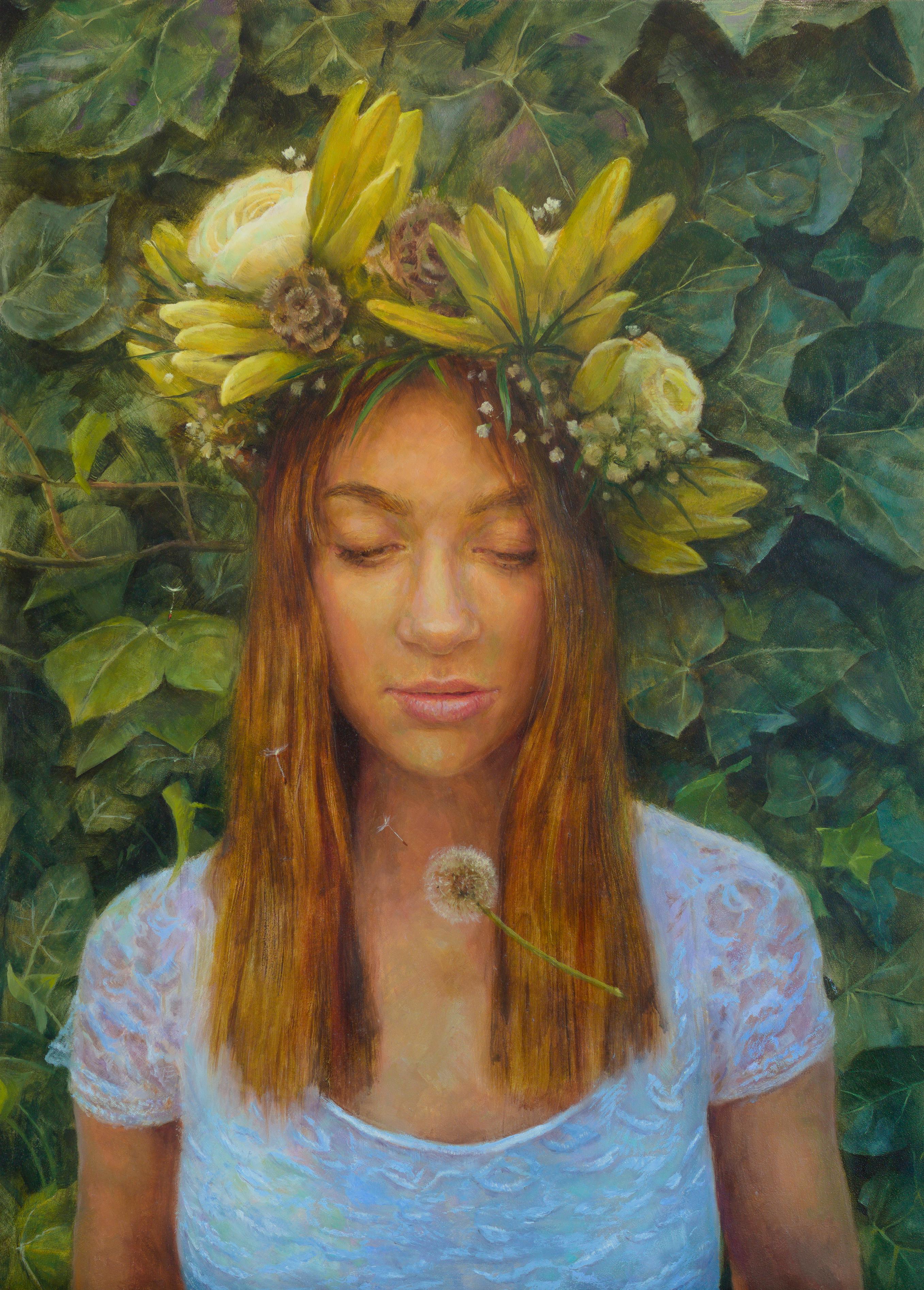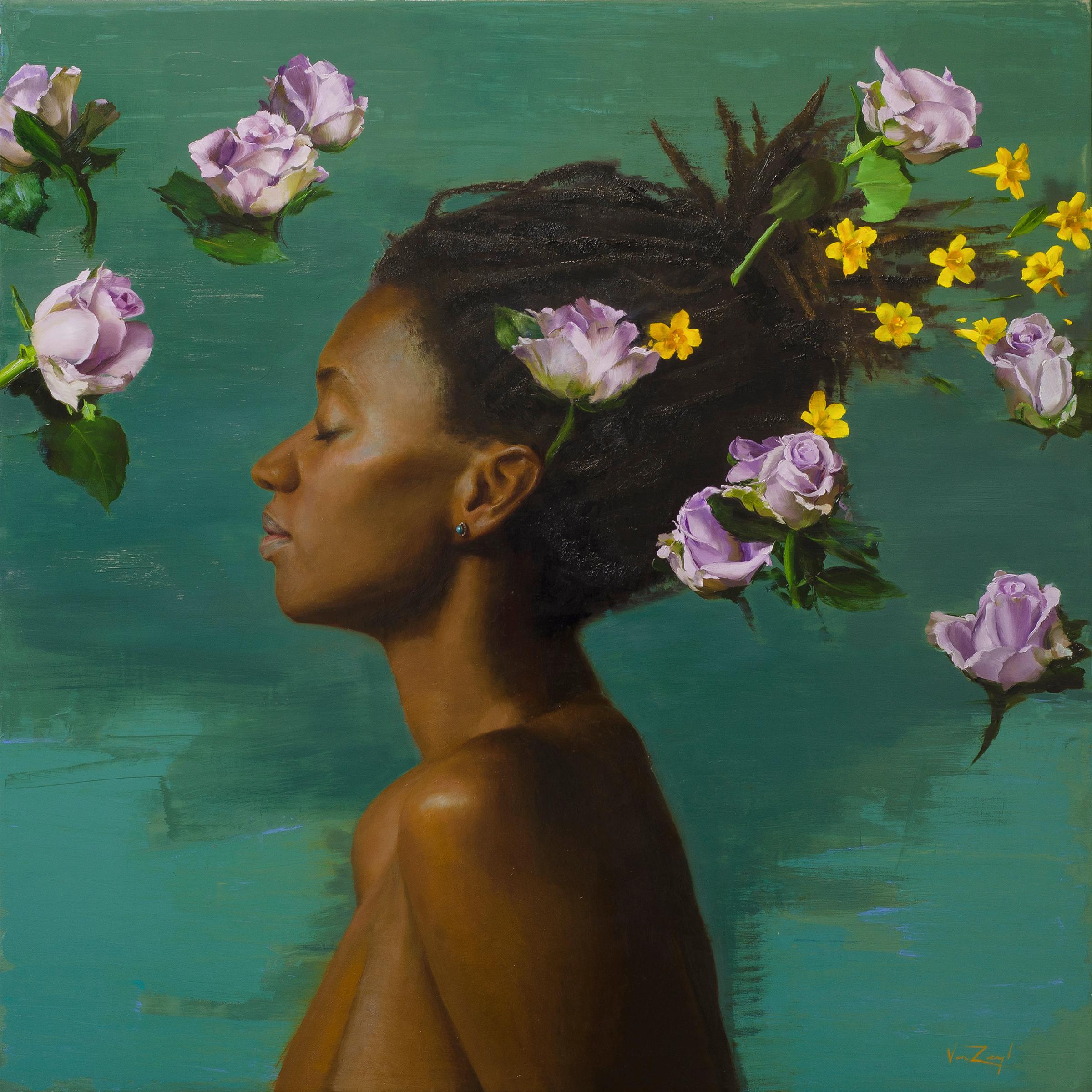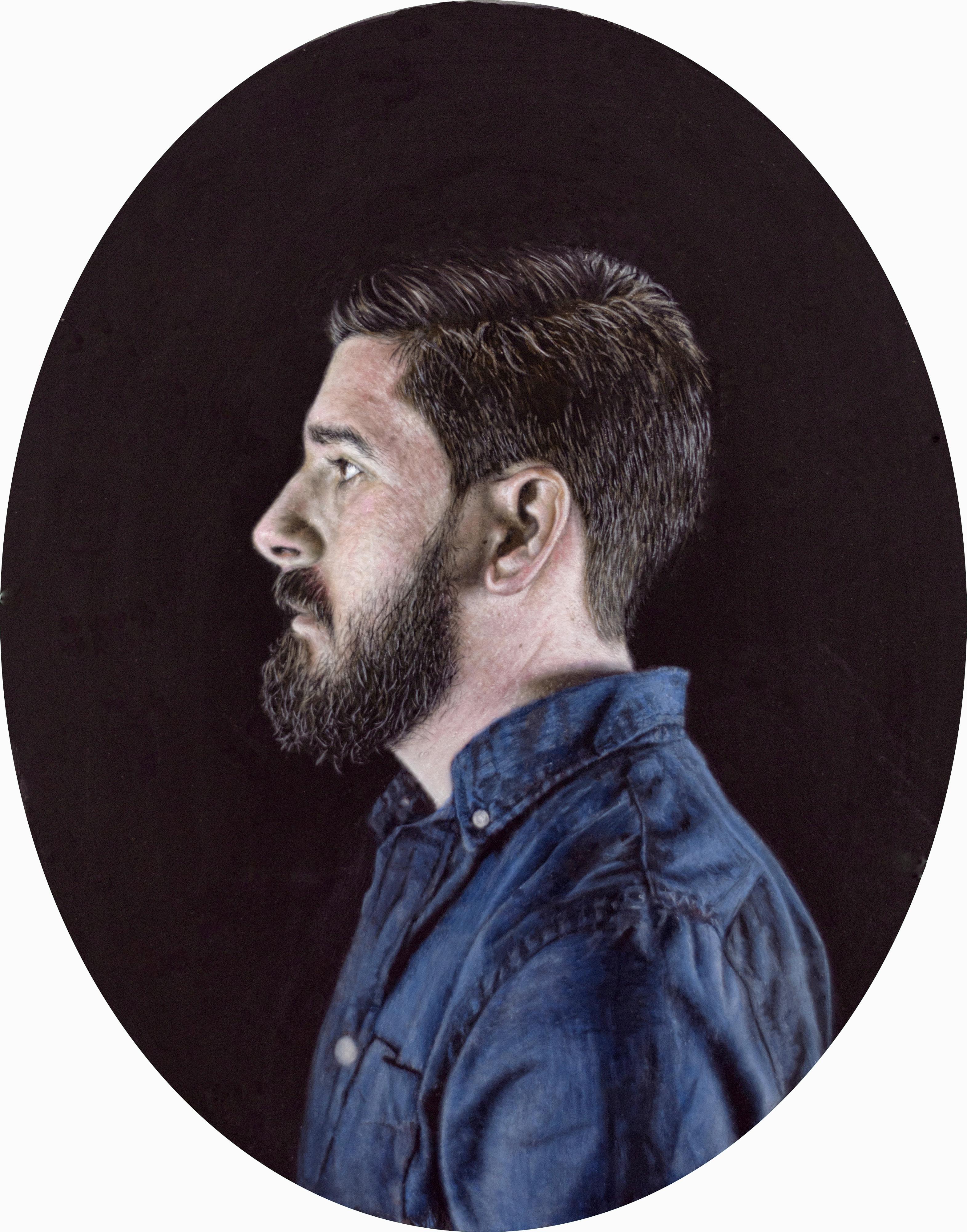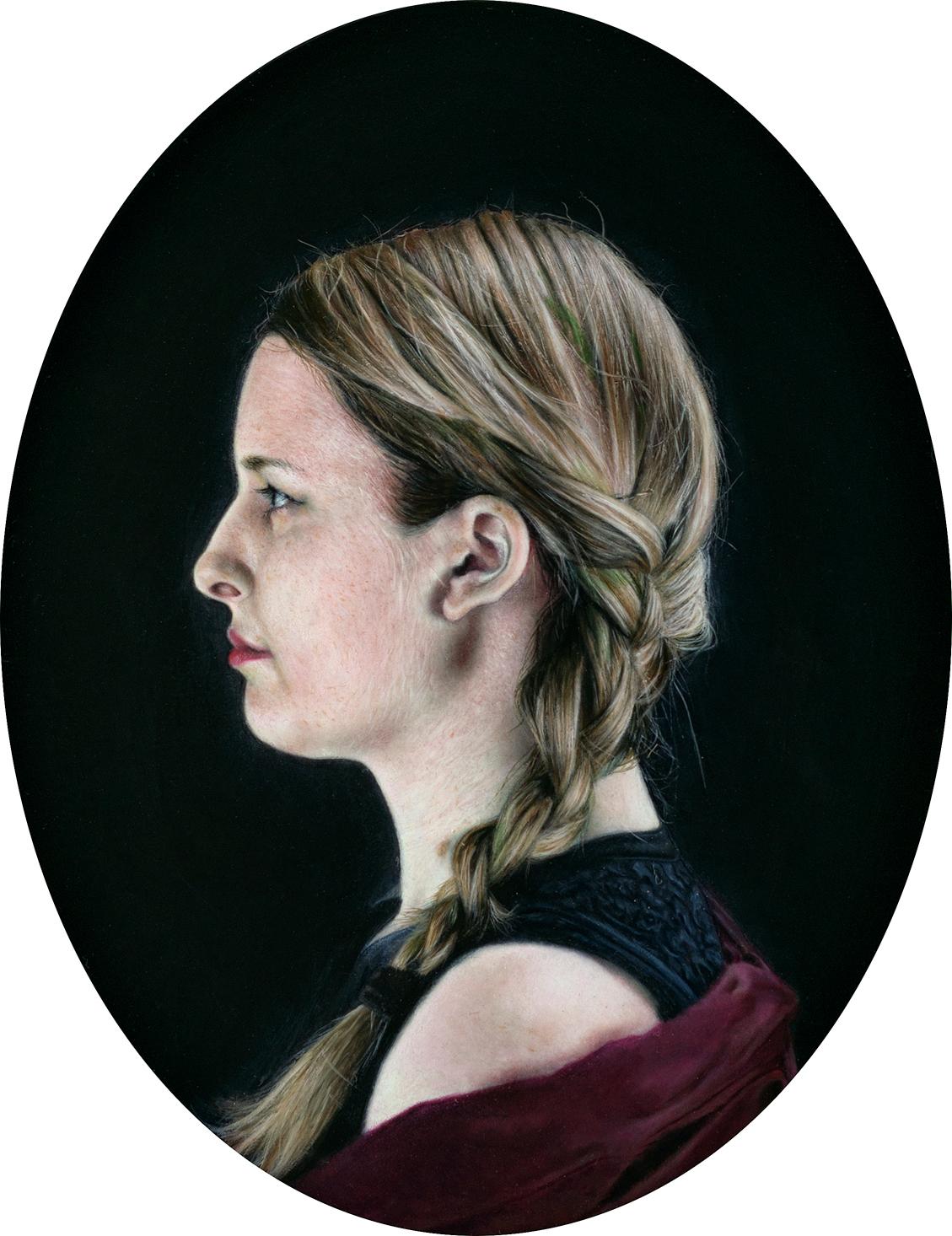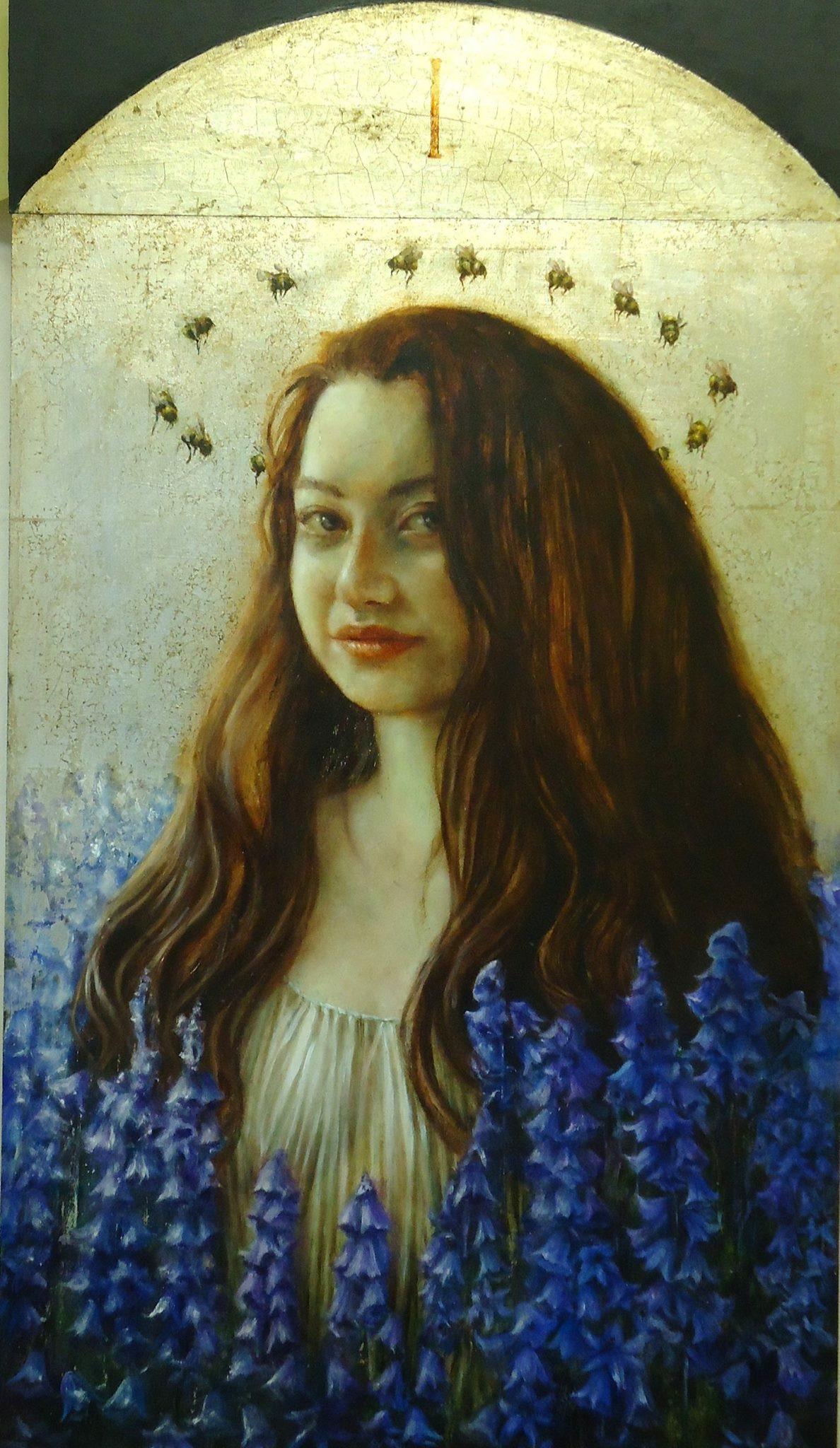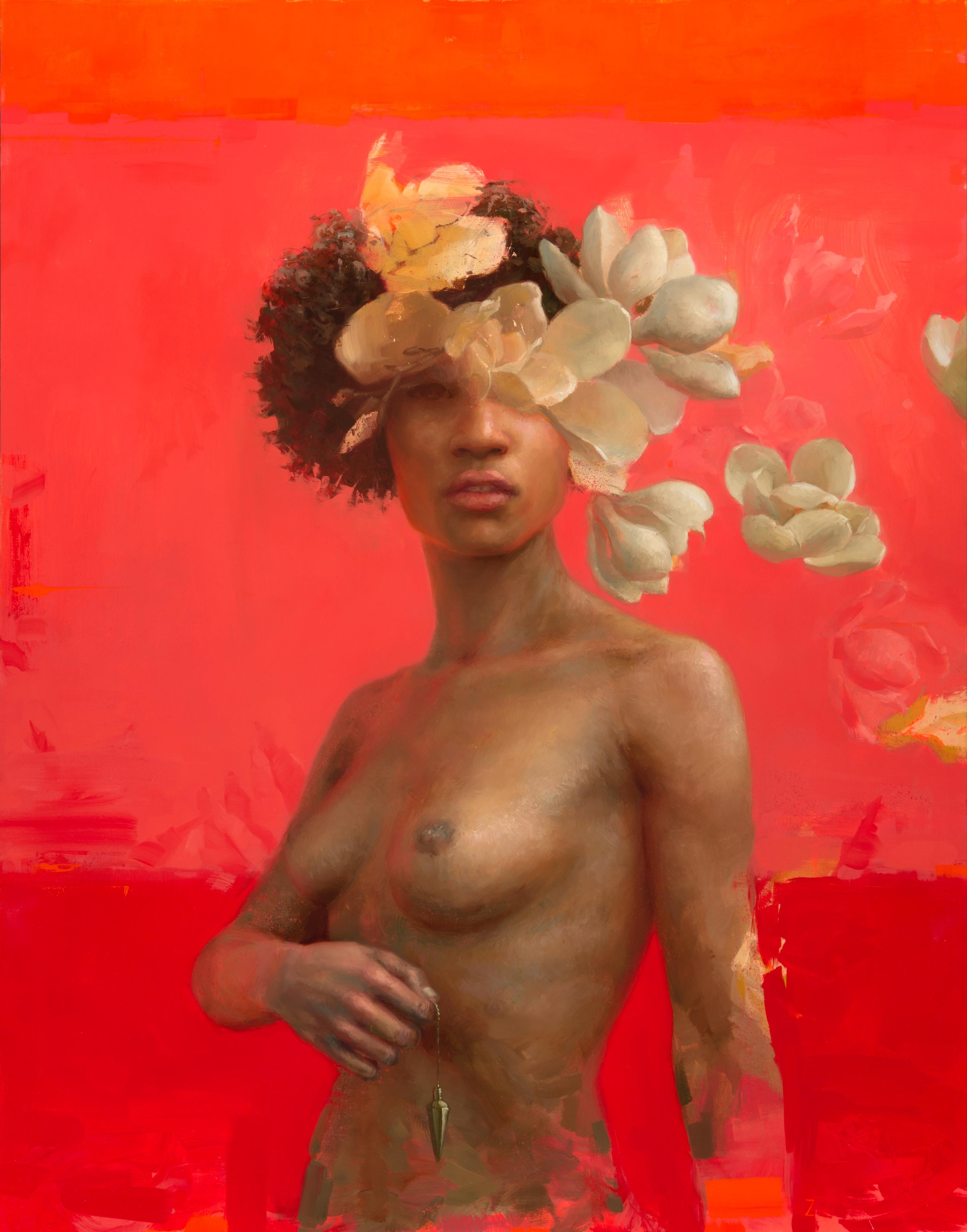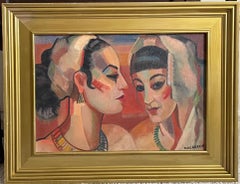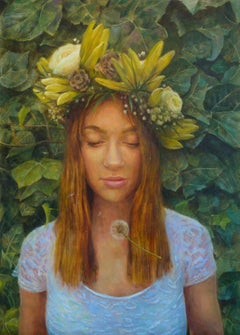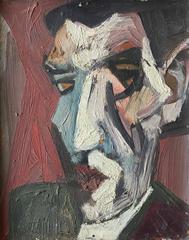
Portrait of Manny
View Similar Items
Want more images or videos?
Request additional images or videos from the seller
1 of 2
Morton DimondsteinPortrait of Manny
About the Item
- Creator:
- Medium:
- Period:
- Condition:
- Gallery Location:Los Angeles, CA
- Reference Number:1stDibs: LU391560943
About the Seller
5.0
Vetted Seller
These experienced sellers undergo a comprehensive evaluation by our team of in-house experts.
Established in 1972
1stDibs seller since 2011
383 sales on 1stDibs
Typical response time: 1 hour
More From This SellerView All
- Lady in the Paris ParkLocated in Los Angeles, CABeautiful young lady in a Paris Park, signed, Original Frame, listed size includes the frame.Category
1950s Impressionist Figurative Paintings
MaterialsPanel, Oil
$788 Sale Price49% Off - AlexandriaBy Buckley MacGurrinLocated in Los Angeles, CABUCKLEY MACGURRIN "ALEXANDRIA" OIL ON CANVAS, SIGNED, TITLED AMERICAN, DATED 1949 EXHIBITED: DALZELL-HATFIELD GALLERY 14 X 20 INCHES Buckley MacGurrin 1896 –1971 Buckley MacG...Category
1940s Art Deco Figurative Paintings
MaterialsOil, Canvas
- BLONDE WITH ART DECO NECKLACELocated in Los Angeles, CABiography from the niece of the artist from during his lifetime. Paintings acquired from the artist.s estate. Max Turner 1925 - 2019 Max Lamar Turner Painter, Sculptor, Teacher and Author. Max Turner was born in Omaha, Nebraska on July 28, 1925. His father was Lance Howard Turner and his mother Mary Irene Turner. In 1927, his family moved to Bingham Canyon, Utah where Max's father extracted copper from a creek that he had diverted to pass through his garage. The town was located in a narrow canyon on the eastern face of the Oquirrh Mountains. In 1938, when Max was 13, his family moved to Midvale, Utah. After completing high school, Max went to work laying rail until he was inducted into the U.S. Navy to serve during W.W. II. There he took an aptitude test and was initially assigned to the medical corp., later transferring to the dental unit. Max was stationed at Port Hueneme, Ventura County, California through the end of the war. When he was discharged in 1946, he remained in Southern California, living in the Los Angeles area. He met a man named Larry Torres and they formed a partnership to do silk screen work primarily for the Colby Poster Printing Company. This lasted about 10 years until the Colby building caught fire and burned down. In 1958, Max began working for Slade Novelty company that made doll parts using a product called plastisol. A year later, Max began producing plastic parts through his own business. One day, a couple of kids brought in a shrunken skull they had made and asked Max if he could reproduce it. Max said he could and he looked around for a business to work with for this task. He ultimately decided he could create his own machine shop to make molds. As a result, Max purchased a lathe, drill press, grinder and other tools to create his own machine shop and went into business making molds. He built a clientele and in 1973, he moved his machine shop to Glendale, California. Painter, Sculptor, Teacher and Author: Max recalls the day when his interest in art took a new direction. He happened to be in a paint store to purchase some supplies when he saw a card posted on a wall that read, "Come paint with Connie Marlo". Max had been interested in art since his youth and he was frequently impressed with paintings displayed by local artists at various community events. Consequently, he decided to go to Connie's Saturday morning art class at a studio on North La Brea Avenue (between Sunset and Hollywood) in Los Angeles. But, as fate would have it, he immediately took a detour from this class when he found a piece of paper on the floor of the studio referencing another art class dealing with compositions, patterns, rhythms and color harmony. The instructor's name was Hal Reed, a former art student of the Russian/American Master, Nicolai Fechin. Hal owned the building (previously the Will Foster Studio) and had founded the Art League of Los Angeles. When Max found Hal, he asked Hal if he could join his class. Hal said "No, the class was full" but he said Max could monitor the class in the back of the classroom. Max took him up on the offer and began observing the weekly class. During the class, Hal told his students that they should practice what they were learning by going to "live model" classes. Max began attending these classes where he learned how to draw figures. After a few months, Hal and Max became good friends. Hal was so impressed with Max's work that he offered Max the opportunity to teach at another location that Hal was opening in the San Fernando Valley. Max accepted the offer and began teaching his own art class. For Max, it was a quick jump from learning to teaching. Max then found that several of his students had to commute to his art class from the west end of the "Valley". To better serve this group of students, Max decided to relocate to another studio in Calabasas. Max continued teaching, and at this time he was producing very impressive portraits, both oil paintings and charcoal drawings from live models (Max never worked from photos). Max demonstrated real talent, and the style of his drawings and paintings were being compared to those of Nicolai Fechin. And, like Fechin, Max also had an interest in sculpting. One day, Max decided to design and cast a bronze owl sculpture to put in his Calabasas Fine Art Gallery. Later, someone approached Max when he was at the foundry and asked him about his success selling the owl sculpture. The individual who asked this question was convinced that there was a broader market for these sculptures and he ordered a dozen of the owl sculptures from Max. This encouraged Max to do more castings. Some of the new castings were antique sculptures he found and reproduced. As this new business grew, he decided to establish his own foundry, employing up to 15 workers. The business continued for many years, up until the late 1990's when Max got tired of the foundry business and sold it. Max, who was now in his 70's, decided to move on to his next venture as an artist, dedicating himself to doing the actual sculpting of original art. He loved the creativity of sculpting and he had his sculptures cast at local foundries, ironically the same ones that used to be his competition. Max was now fully engaged in his new artistic direction and, over time, he produced a large body of work. He created very impressive sculptures, including about 100 full-size sculptures. He sold some of these to high-end clientele, the Foundry at SLS Las Vegas, and to Hollywood studios. Even though Max now seemed to be totally in his element, he somehow also found time to continue to teach painting classes at the California Art Institute in Westlake Village in Los Angeles. At the institute, he specialized in figure work. Max continued to draw, paint and teach, but he says he stopped sculpting when he turned 90. Max produced four books showcasing his drawings and paintings. The first is "Faces, The Drawings of Max Turner", copyright 2000, that showcases nearly 100 of his portrait drawings. Within the "Acknowledgements" section, he lists Hal Reed and Joseph Nordmann, two former students of Nicolai Fechin. In 2006, Max produced his second book titled "Figures and Faces", reflecting not only portraits but also figure drawings and paintings. It is a wonderful book of Max's work, but it is currently difficult to find. The third book is titled "Faces 2, The Paintings and Drawings of Max Turner", copyright 2009, which includes 75 portrait paintings and drawings. In the "Preface" of this book, Max describes growing up in a small and isolated mining town during the Great Depression. He states that as a kid, he had little exposure of any culture or view of what the rest of the world was like. His neighbor was the trash collector and Max would sometimes go through his truck looking for anything of value. Among other things, he found magazines like Cosmopolitan, Good Housekeeping and Red Book, with covers that frequently showed drawings or paintings of faces. Max states that these images were the very first source of inspiration for him. He says that he began looking more carefully at people's faces and if they had character, he would draw them. By drawing them, Max says that he was making them part of his world, his world of "Faces". In 2018, Max published his newest book showcasing his drawings and paintings. It is titled "Max Turner's Figure Sketches". This softbound book includes 76 pages and over 120 drawings and paintings. In the Introduction, Max explains "I have found that when approaching the figure, one should begin with the gesture. After having captured the essence or feeling of the pose, one can then proceed to build on it." The figure sketches in this wonderful book reflect a Master's work that consistently captures the "gesture"-showing the emotion, movement and expression. Two more books are on the horizon for Max, both dealing with his passion for sculpting. His first, "The Sculpture of Max Turner" is a compilation of his commercial and noncommercial pieces throughout his career. The second, "Terra Cotta Sculpture by Max Turner" is a complete collection of figures done at the California Art Institute. These much anticipated books should be out later in 2018. Max now considers himself primarily a sculptor. But others in the art world are more than impressed with his drawings and paintings as well. His portraits are often described as having a Fechin-esque appearance, referring to the style of Nicolai Fechin. When Max observed those first art classes given by Hal Reed, it should be noted that Hal had previously been a student of the Russian/American Master Nicolai Fechin in the early to mid-1950's. In fact, Hal was a student in the last art class that Fechin taught before he unexpectedly died in 1955. Hal was so strongly influenced by Fechin that he later produced two 30-minute art instruction videos as part his Art Video Productions wherein he specifically described Fechin techniques that he learned in Fechin's class. The Fechin style and techniques were in play when Max later met Hal. Over the years, many of Max's art students, art collectors, gallery owners, as well as the Director of the Monterey Museum of Art have commented on the Fechin-esque qualities of Max's wonderful charcoal drawings and paintings. So, while Max may consider himself primarily a sculptor, his drawings and paintings are also impressive and very much sought after. When Nicolai Fechin died in 1955, three of the nine students in his last art class became life-long friends. Max subsequently became friends with not only Hal Reed, but also with prior Fechin students Joseph Nordmann and Albert Londraville...Category
1990s Modern Figurative Paintings
MaterialsCanvas, Oil
$650 Sale Price48% Off - LADY WITH PICK FANLocated in Los Angeles, CABiography from the niece of the artist from during his lifetime. Paintings acquired from the artist.s estate. Max Turner 1925 - 2019 Max Lamar Turner Painter, Sculptor, Teacher and Author. Max Turner was born in Omaha, Nebraska on July 28, 1925. His father was Lance Howard Turner and his mother Mary Irene Turner. In 1927, his family moved to Bingham Canyon, Utah where Max's father extracted copper from a creek that he had diverted to pass through his garage. The town was located in a narrow canyon on the eastern face of the Oquirrh Mountains. In 1938, when Max was 13, his family moved to Midvale, Utah. After completing high school, Max went to work laying rail until he was inducted into the U.S. Navy to serve during W.W. II. There he took an aptitude test and was initially assigned to the medical corp., later transferring to the dental unit. Max was stationed at Port Hueneme, Ventura County, California through the end of the war. When he was discharged in 1946, he remained in Southern California, living in the Los Angeles area. He met a man named Larry Torres and they formed a partnership to do silk screen work primarily for the Colby Poster Printing Company. This lasted about 10 years until the Colby building caught fire and burned down. In 1958, Max began working for Slade Novelty company that made doll parts using a product called plastisol. A year later, Max began producing plastic parts through his own business. One day, a couple of kids brought in a shrunken skull they had made and asked Max if he could reproduce it. Max said he could and he looked around for a business to work with for this task. He ultimately decided he could create his own machine shop to make molds. As a result, Max purchased a lathe, drill press, grinder and other tools to create his own machine shop and went into business making molds. He built a clientele and in 1973, he moved his machine shop to Glendale, California. Painter, Sculptor, Teacher and Author: Max recalls the day when his interest in art took a new direction. He happened to be in a paint store to purchase some supplies when he saw a card posted on a wall that read, "Come paint with Connie Marlo". Max had been interested in art since his youth and he was frequently impressed with paintings displayed by local artists at various community events. Consequently, he decided to go to Connie's Saturday morning art class at a studio on North La Brea Avenue (between Sunset and Hollywood) in Los Angeles. But, as fate would have it, he immediately took a detour from this class when he found a piece of paper on the floor of the studio referencing another art class dealing with compositions, patterns, rhythms and color harmony. The instructor's name was Hal Reed, a former art student of the Russian/American Master, Nicolai Fechin. Hal owned the building (previously the Will Foster Studio) and had founded the Art League of Los Angeles. When Max found Hal, he asked Hal if he could join his class. Hal said "No, the class was full" but he said Max could monitor the class in the back of the classroom. Max took him up on the offer and began observing the weekly class. During the class, Hal told his students that they should practice what they were learning by going to "live model" classes. Max began attending these classes where he learned how to draw figures. After a few months, Hal and Max became good friends. Hal was so impressed with Max's work that he offered Max the opportunity to teach at another location that Hal was opening in the San Fernando Valley. Max accepted the offer and began teaching his own art class. For Max, it was a quick jump from learning to teaching. Max then found that several of his students had to commute to his art class from the west end of the "Valley". To better serve this group of students, Max decided to relocate to another studio in Calabasas. Max continued teaching, and at this time he was producing very impressive portraits, both oil paintings and charcoal drawings from live models (Max never worked from photos). Max demonstrated real talent, and the style of his drawings and paintings were being compared to those of Nicolai Fechin. And, like Fechin, Max also had an interest in sculpting. One day, Max decided to design and cast a bronze owl sculpture to put in his Calabasas Fine Art Gallery. Later, someone approached Max when he was at the foundry and asked him about his success selling the owl sculpture. The individual who asked this question was convinced that there was a broader market for these sculptures and he ordered a dozen of the owl sculptures from Max. This encouraged Max to do more castings. Some of the new castings were antique sculptures he found and reproduced. As this new business grew, he decided to establish his own foundry, employing up to 15 workers. The business continued for many years, up until the late 1990's when Max got tired of the foundry business and sold it. Max, who was now in his 70's, decided to move on to his next venture as an artist, dedicating himself to doing the actual sculpting of original art. He loved the creativity of sculpting and he had his sculptures cast at local foundries, ironically the same ones that used to be his competition. Max was now fully engaged in his new artistic direction and, over time, he produced a large body of work. He created very impressive sculptures, including about 100 full-size sculptures. He sold some of these to high-end clientele, the Foundry at SLS Las Vegas, and to Hollywood studios. Even though Max now seemed to be totally in his element, he somehow also found time to continue to teach painting classes at the California Art Institute in Westlake Village in Los Angeles. At the institute, he specialized in figure work. Max continued to draw, paint and teach, but he says he stopped sculpting when he turned 90. Max produced four books showcasing his drawings and paintings. The first is "Faces, The Drawings of Max Turner", copyright 2000, that showcases nearly 100 of his portrait drawings. Within the "Acknowledgements" section, he lists Hal Reed and Joseph Nordmann, two former students of Nicolai Fechin. In 2006, Max produced his second book titled "Figures and Faces", reflecting not only portraits but also figure drawings and paintings. It is a wonderful book of Max's work, but it is currently difficult to find. The third book is titled "Faces 2, The Paintings and Drawings of Max Turner", copyright 2009, which includes 75 portrait paintings and drawings. In the "Preface" of this book, Max describes growing up in a small and isolated mining town during the Great Depression. He states that as a kid, he had little exposure of any culture or view of what the rest of the world was like. His neighbor was the trash collector and Max would sometimes go through his truck looking for anything of value. Among other things, he found magazines like Cosmopolitan, Good Housekeeping and Red Book, with covers that frequently showed drawings or paintings of faces. Max states that these images were the very first source of inspiration for him. He says that he began looking more carefully at people's faces and if they had character, he would draw them. By drawing them, Max says that he was making them part of his world, his world of "Faces". In 2018, Max published his newest book showcasing his drawings and paintings. It is titled "Max Turner's Figure Sketches". This softbound book includes 76 pages and over 120 drawings and paintings. In the Introduction, Max explains "I have found that when approaching the figure, one should begin with the gesture. After having captured the essence or feeling of the pose, one can then proceed to build on it." The figure sketches in this wonderful book reflect a Master's work that consistently captures the "gesture"-showing the emotion, movement and expression. Two more books are on the horizon for Max, both dealing with his passion for sculpting. His first, "The Sculpture of Max Turner" is a compilation of his commercial and noncommercial pieces throughout his career. The second, "Terra Cotta Sculpture by Max Turner" is a complete collection of figures done at the California Art Institute. These much anticipated books should be out later in 2018. Max now considers himself primarily a sculptor. But others in the art world are more than impressed with his drawings and paintings as well. His portraits are often described as having a Fechin-esque appearance, referring to the style of Nicolai Fechin. When Max observed those first art classes given by Hal Reed, it should be noted that Hal had previously been a student of the Russian/American Master Nicolai Fechin in the early to mid-1950's. In fact, Hal was a student in the last art class that Fechin taught before he unexpectedly died in 1955. Hal was so strongly influenced by Fechin that he later produced two 30-minute art instruction videos as part his Art Video Productions wherein he specifically described Fechin techniques that he learned in Fechin's class. The Fechin style and techniques were in play when Max later met Hal. Over the years, many of Max's art students, art collectors, gallery owners, as well as the Director of the Monterey Museum of Art have commented on the Fechin-esque qualities of Max's wonderful charcoal drawings and paintings. So, while Max may consider himself primarily a sculptor, his drawings and paintings are also impressive and very much sought after. When Nicolai Fechin died in 1955, three of the nine students in his last art class became life-long friends. Max subsequently became friends with not only Hal Reed, but also with prior Fechin students Joseph Nordmann and Albert Londraville...Category
1990s Modern Figurative Paintings
MaterialsCanvas, Oil
$450 Sale Price64% Off - PORTRAIT OF ANHALT PORTRAIOTBy Morton DimondsteinLocated in Los Angeles, CA"PORTRAIT OF ANHALT PORTRAIOT" FILM MAKER OIL ON PAPER C.1970 17.5 X 22.5 INCHES Morton Dimondstein 1920-2000 At the age of seventeen Morton Dimondstein enrolled in ...Category
1970s Figurative Paintings
MaterialsOil, Rag Paper
$1,200 Sale Price38% Off - Woman with DogBy Reza AfrookhtehLocated in Los Angeles, CASize with frame: 34 x 28 Inches Reza begun studying art seriously at age 15 and was studying at the institute of art in Iran where he graduated with highest honors. He also studied...Category
Early 2000s Realist Figurative Paintings
MaterialsCanvas, Oil
Price Upon Request
You May Also Like
- Free Spirit- 21st Century Contemporary Portrait Painting of a young girlBy Erik van ElvenLocated in Nuenen, Noord BrabantErik van Elven Free Spirit 70 x 50 cm Oil on dibond ( panel ) Framed 78 x 58 cm ( This frame is included in the price ) Erik van Elven did build a wonderful career as an artist in H...Category
2010s Contemporary Portrait Paintings
MaterialsPanel, Oil
- Terra Nullis-21st Century Contemporary Iconic Painting of a Girl in blue dressBy Pam HawkesLocated in Nuenen, Noord BrabantThis British artist is new to the Netherlands, her work is now a household name in the rest of the world. We understand why. A painting by Pam Hawkes is something remarkable. At th...Category
2010s Contemporary Portrait Paintings
MaterialsCopper
- Silverstone Yellow Jasmine - Original Oil Painting of Woman and Floating FlowersBy Michael Van ZeylLocated in Chicago, ILARTIST STATEMENT I'm currently working with figures and portraits and combine human forms with botanicals to explore our relationship with natural elements. Capturing the movement of the figure or an expression of a living soul presents endless possibilities and inspiration enabling me to blend with different themes. I've studied classical methods of oil painting with a focus on the 17th century Dutch Masters. The subjects I am drawn to are individuals with character, athletic figures and blooming floral arrangements with elegance and ethereal beauty. The reference for my work comes from my direct observation of natural day light in my north light studio illuminating and blanketing the form of my subjects. I am fascinated and challenged by the process of transforming a flat, blank canvas into the illusion of dimensional form, atmosphere and mood. That process is usually well thought out but sometimes painted direct and use intuition to complete my idea. Both of these methods present challenges but each way fills the void of the other and opens up the possibility of new visual ideas to meet my objective. BIOGRAPHY For Michael Van Zeyl, portraiture is much more than a one-sided translation of the artist’s point of view taking form in a subject. It’s an engaging visual dialogue that renders a soul in light, shadow and pigment, continuing the conversation for future generations to appreciate. While subtle observation and technical skill are only part of Michael’s gift, his experience has honed his craft to the highest standard. His talents were apparent by age seven and he spent subsequent decades mastering a wide range of painting techniques. In particular, 17th century Dutch and 19th century impressionist styles have resonated with him and surfaced in his own works. His formal training began at the American Academy of Art in Chicago, continuing on at Chicago’s Historic Palette & Chisel Academy and the Art Students League in New York, where he studied with the most accomplished artists who also paint directly from life under natural light. Michael is currently a faculty and board member at the Palette & Chisel and has been the club’s most popular instructor for several years. Michael’s work is already appreciated in many public and private collections, such as the United States District Court, University of Chicago, DePaul University School of Law, Chicago Theological Seminary and American Hotel Register. He has received awards from the Portrait Society of America, The Artists Guild, the Oil Painters of America and the 2014 recipient of the Dorothy Driehaus Mellin Fellowship for Midwestern Artists. EDUCATION 1987-1990 American Academy of Art, Chicago, IL 1999-2000 American Academy of Art, Chicago, IL - Life Drawing & Oil Painting Palette & Chisel Academy, Chicago, IL - Painting & Life Drawing Art Students League, New York, NY - Painting EXHIBITIONS 2017 “Anne Harris...Category
21st Century and Contemporary Contemporary Figurative Paintings
MaterialsPanel, Oil
- The Artist in Profile - Oval Shaped Portrait Painting in Extraordinary DetailBy Matthew CookLocated in Chicago, ILMatthew Cook The Artist in Profile oil on aluminum 10 x 8 in. oval MATTHEW COOK b. Toledo, OH, 1987 EDUCATION 2017 MFA, Bowling Green State University...Category
2010s Contemporary Portrait Paintings
MaterialsPanel, Oil
- Joanne in Profile - Photorealist Oil Painting on Oval Panel of Woman in ProfileBy Matthew CookLocated in Chicago, ILThis is a painting in realistic detail of a woman in profile using subtle tones. The oval shaped panel is framed in a custom frame with classic details. Matthew Cook...Category
2010s Contemporary Portrait Paintings
MaterialsPanel, Oil
- Turn to stone - 21st century. pride figure painting of a Female CoupleBy Marten HuitsingLocated in Nuenen, Noord BrabantMarten Huitsing 'Turn to stone' 53 x 80 cm framed ( frame is included ) 63 x 90 cm Oil on wood panel In this painting Marten Huitsing paints a just m...Category
2010s Contemporary Figurative Paintings
MaterialsWood Panel, Oil
